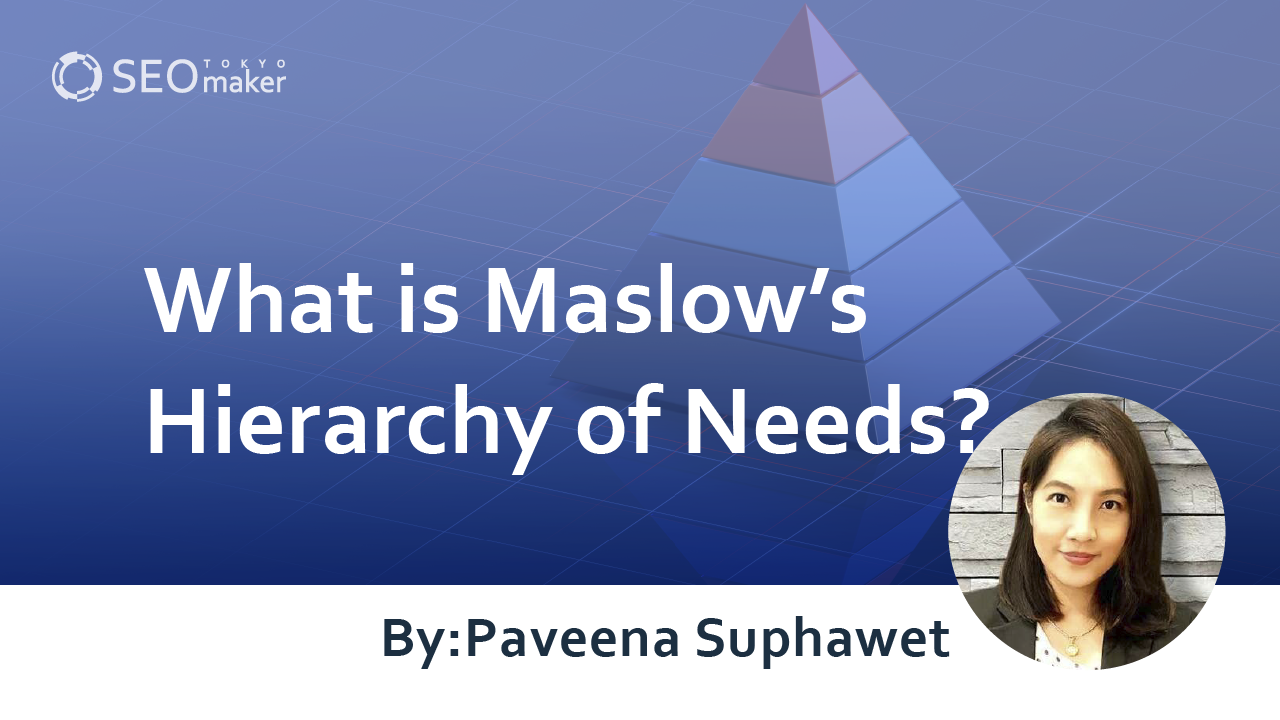What is Maslow’s Hierarchy of Needs? : Points for Marketing

Maslow’s Hierarchy of Needs is a psychological theory proposing that human needs are arranged in five levels. Since human needs drive behavior, this concept is applicable in business.
It is frequently used in organizational development, marketing, and SEO to strategize and boost motivation.
This article focuses on explaining the five levels of needs and how to apply Maslow’s principles in business.
Maslow’s Hierarchy of Needs
Developed by American psychologist Abraham Harold Maslow, this theory organizes human needs into a pyramid-shaped hierarchy, often referred to as Maslow’s Hierarchy of Needs or the theory of self-actualization.
According to Maslow, human needs are structured into the following five levels
- Physiological Needs
- Safety Needs
- Social Needs (Belongingness)
- Esteem Needs
- Self-Actualization Needs
Maslow’s theory, despite criticisms regarding its scientific rigor and perceived Western bias, remains relevant and is used in various fields like marketing and organizational development. Understanding these needs or insights into human behavior can enhance user understanding and SEO strategies.
Mazlow’s Law is a widely renowned theory, often utilized in marketing and organizational development. This theory delves into human needs, encompassing desires and wants, which can provide valuable insights into user psychology, leading to applications in SEO (Search Engine Optimization).
While Mazlow’s Law has been criticized for its limited sample size, lacking scientific rigor, and bias towards Western values and ideologies, there’s still much to learn from it. Understanding its concepts can be beneficial for business despite these critiques.
The Five Levels of Maslow’s Hierarchy
- Physiological Needs
- Safety Needs
- Social Needs (Belongingness)
- Esteem Needs
- Self-Actualization Needs
Physiological Needs
Physiological needs represent the most basic human requirements.
They are essential for sustaining life, encompassing the primary human needs like hunger, sleep, and sex, as well as fundamental activities such as breathing and excretion.
In the workplace, this translates to earning money for living rather than aligning with company values or societal acceptance.
Safety Needs
Safety needs arise once physiological needs are satisfied, driving the desire for physical safety and financial stability.
Once basic survival needs are met, it’s natural to seek additional security. Avoiding physical danger and desiring economic stability are instinctive responses.
In a work context, this means preferring a job without excessive labor, long hours, or harassment.
Social Needs (Love/Belonging)
Social needs relate to the desire to belong to and be active within a group, like a family or organization. Also known as belongingness or the need for love and belonging.
Even with sufficient resources and safety, the absence of acceptance can lead to loneliness and mental strain.
This need reflects the desire to escape isolation and find a sense of belonging.
In the workplace, once basic employment conditions are met, the next aspiration is to develop positive relationships with colleagues and superiors.
Esteem Needs
Esteem needs involve the desire to be highly regarded and acknowledged within a group.
Being part of an organization means more than just belonging. It involves interaction, cooperation, and achievement.
Esteem needs are about wanting to enhance one’s accomplishments and gain recognition from others. These needs are categorized into lower and higher levels.
Lower esteem needs reflect the desire for praise and attention from others, while higher esteem needs pertain to self-respect, achieving personal goals, and self-validation.
In the workplace, this translates to wanting job success, recognition for achievements, and aspirations for advancement.
Self-Actualization Needs
Once esteem needs are met, self-actualization becomes the focus. Satisfying higher esteem needs leads to aspirations for personal fulfillment and living authentically. This stage is about realizing one’s true potential.
Even after achieving professional success or advancement, individuals may still strive for their ideal career or seek independence, experiencing a conflict between ideals and reality. Self-actualization is achieved when these are aligned.
In professional terms, this means contributing to society through one’s work or starting a business to pursue personal interests.
Sixth Stage Self-Transcendence
While Maslow’s hierarchy typically concludes with self-actualization, later in his life, Maslow introduced a higher level called self-transcendence.
Self-transcendence is about aspiring to improve society and operating beyond the self. Unlike self-actualization, which focuses on personal fulfillment, self-transcendence directs attention outward, towards society and others.
For instance, Keanu Reeves is known for his significant philanthropy. He famously said, “Money is the last thing I think about. I could live on what I have already made for the next few centuries,” and “I’ve made enough money. I want to enjoy life without the stress of banking millions. Just carrying a suitcase to the hotel is enough. Being healthy is more important than money.” These reflect the actions of someone who has met their financial and esteem needs, indicating a movement towards self-transcendence, where large donations are often made by the affluent out of altruistic motives.
This type of behavior is believed to be driven by the desire for self-transcendence, stemming from genuine intentions.
Classification of the Five Levels of Needs
Maslow’s five levels of needs are categorized based on their nature into;
- Material and Psychological
- External and Internal
- Deficiency and Growth
Material and Psychological
Material needs relate to physiological and safety needs, such as food, water, and shelter, requiring physical resources. Psychological needs, beginning from social needs upwards, pertain to emotional satisfaction and mental well-being.
External and Internal
Until social needs, the focus is on external environmental factors, but from esteem needs onwards, the focus shifts inward, categorizing needs into external and internal.
Deficiency and Growth
Needs up to esteem are deficiency needs, driven by the absence of something. In contrast, self-actualization represents growth needs, motivated by a desire for personal development.
Applying Maslow’s Hierarchy Tips and Strategies
Maslow’s hierarchy is utilized in marketing and SEO, helping to analyze and fulfill target customers’ needs, leading to the creation of customer journey maps. This analysis guides marketing and SEO strategies.
The key aspect of this theory is its hierarchical structure, where fulfilling lower-level needs prompts actions to satisfy higher-level needs.
Understanding this progression of user behavior can influence product development, upselling, and cross-selling. To leverage Maslow’s theory in marketing and SEO, consider these three points:
- Contemplate Motivation
- Anticipate Ascending Needs
- Align Services with the Hierarchy
Considering Motivation
Maslow posited that human actions are driven by two types of motivations: deficiency and growth.
The motivation to act comes from the desire to fulfill something perceived as lacking, involving the first four needs (physiological, safety, social, and esteem). In marketing, contemplating how to satisfy these deficiency needs is crucial. For individuals whose primary needs are met, growth becomes the motivational factor.
Inversely, if basic needs are not sufficiently met, growth does not become a motivational driver, making this distinction useful in identifying target desires.
Needs Continue to Rise
From a marketing perspective, Maslow’s hierarchy is valuable in understanding consumer purchasing needs. As markets mature, needs become more complex, rooted in the five fundamental needs. However, once one need is satisfied, the next higher need emerges, necessitating a thorough comprehension of evolving consumer demands.
Aligning Company Services with the Hierarchy
To leverage Maslow’s hierarchy in marketing and SEO strategies, align your products or services with the five levels of needs. Even within the same industry, different services can satisfy different levels of needs and target different groups.
The approach to selling can change based on perspective and target audience, even if the solutions appear similar.
Summary
Maslow’s hierarchy represents the five levels of human needs, but beyond these, additional desires exist, which can be categorized and utilized in marketing and SEO. A critical aspect of this theory is the continual escalation of needs, indicating the endless nature of human desires. While offering business opportunities, it’s essential to blend this Western-centric theory appropriately into the marketing strategies suited for your company, rather than fully relying on it.










![What is a Description? Explaining the Meaning, Writing Style, and Changing Word Count – [2023 Edition]](https://www.switchitmaker2.com/en/wp-content/uploads/2024/09/what-is-description.webp)










